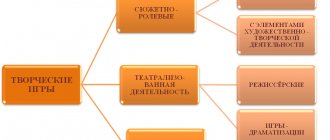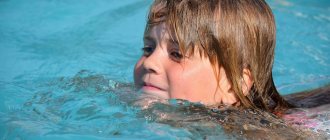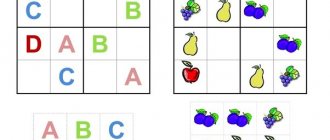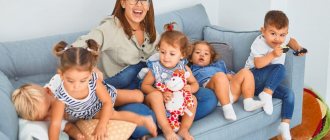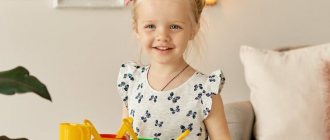How to organize a group environment. Junior groups
Young age is the most important stage in a child’s development. It is during this period that his transition to new relationships with adults, peers and the objective world occurs. The main tasks of this stage: ensuring emotionally positive well-being, encouraging independence, accumulating experience in subject-cognitive and communicative activities.
The environment in junior groups is created primarily as comfortable and safe for the child.
Young children are doers; therefore, their stay in a preschool institution should be organized so that everyone has the opportunity to participate in games, motor exercises, and examination of the properties and qualities of objects.
The desire for independence is formed in the youngest preschooler in collaboration with adults, in joint activities with them. Taking this into account, the space is organized so that two or three children and an adult can act simultaneously.
Younger preschoolers are actively developing various movements; at the same time, they are still poorly coordinated, there is no dexterity, speed of reaction, or evasiveness. Therefore, it is advisable to place the equipment around the perimeter of the group, allocate a play corner and a place for household needs, and provide sufficiently wide, clearly visible paths for the child’s movement. You should not use a lot of equipment - about two thirds should be free.
To stimulate physical activity, it is necessary to have a slide with steps and a gentle descent, equipment for crawling, creeping, climbing over (plastic cubes with holes or labyrinths). You can use a mattress on which children will happily jump, lie, and crawl. A bright applique with shapes or a fairy-tale plot will make the attribute even more attractive. Two or three large colorful beach balls and several smaller ones will encourage walking. It is advisable to have one or two large strollers for dolls, one or two large cars (which the child himself can ride in). Objects in the immediate environment are a source of curiosity for the baby and the beginning of knowledge of the world, therefore the objective environment should be organized so that the child accumulates sensory experience and is active.
It is important to remember: he sees a lot for the first time and perceives it as a kind of standard with which he will compare everything he sees later.
The subject environment of the group is organized in such a way as to facilitate the development of analyzers and “suggest” methods of examination and action. Items are selected in pure colors, simple shapes, different sizes, and made from materials that are safe for the child’s health.
It’s good if you can extract sounds from objects, smell them, know the nature of the surface (smoothness, roughness), transparency, hardness-softness, etc.
Enriching the child’s gaming experience becomes the object of close attention of the teacher.
The game helps create a cheerful, cheerful mood in children and awakens the desire to communicate with adults and peers. It is known that independent play actions are stimulated by toys. They must be, first of all, functional and general in nature (for example, it is important that a car has a body, wheels, and a cabin so that it can be rolled.
In a group for children 4 years old, you can use toys that reflect real life (for example, an ambulance, a truck, a car, a doctor doll, etc.). A number of game attributes can be replaced with substitute objects, which promotes the development of imagination and expands the creative possibilities of the game.
All toys and aids in the group must be accessible to the child - this contributes to the development of his activity and independence.
Many opportunities for children's development lie in experimental play. Games with sand, water, clay, and paints require special equipment (containers for pouring water, small rubber and floating toys, water mills, etc., ping-pong balls, foam sponges, molds, buckets, pebbles). It is better to place such a play area closer to the water source, lay a plastic mat or oilcloth in this place, and have several sets of protective clothing.
In groups for children of primary preschool age, the focus is on comparing quantities, objects by quantity and properties. This is facilitated by didactic games (such as lotto and paired pictures), mosaics (for 3-year-old children - large plastic, for 4-year-olds - magnetic and large nail), puzzles of 3-15 pieces, sets of cubes of 4-12 pieces, educational games (for example, “Fold the pattern”, “Fold the square”), as well as games with elements of modeling and substitution.
Children are showing an increasingly active interest in drawing. To maintain and develop it, it is better to have self-erasing or wax boards with a drawing stick or a roll of white wallpaper and wax crayons.
Senior and pre-school groups
At this age, it is important to develop any manifestations of the “self” of preschoolers: independence, self-organization, self-esteem, self-control, self-knowledge, self-expression. It is necessary to cultivate a humane attitude towards the natural, objective and social world. All this requires the child to constantly turn to the inner world and expand the boundaries of the external world. When a child moves to the senior group, and especially to the preparatory school group, his psychological position changes: he begins to feel like he is the eldest among other preschool children.
It is important to support this feeling by organizing the environment in which the child will actively demonstrate cognitive activity, independence, responsibility, and initiative. The teacher should more often involve older preschoolers in creating the environment, find out their opinion about planned actions to change the environment, and involve them in the process of transformation.
The subject-game environment is organized in such a way that every child has the opportunity to do what he loves. Placing equipment according to the principle of non-rigid centering allows children to unite into subgroups of interests in the center of construction, art, play (role-playing, directing, theatrical), nature and experimentation; literacy (book corner, games and equipment for speech development), etc.
Older preschoolers develop an interest in problems that go beyond their personal experience. This is reflected in an environment that allows one to expand the child’s personal experience (get to know the animals and plants of distant countries, the customs and appearance of different peoples and eras, different genres of painting, etc.).
It is advisable to divide the group space into semi-enclosed spaces (in which three to six people can be present at the same time), placing the shelves facing the walls and securing them well. It is better to purchase racks and cabinets on wheels so that children, together with the teacher, can change the spatial organization of the environment several times a year according to their own plans. Small screens, wooden or metal frames and pieces of fabric, and large modular material are also suitable for this.
Play continues to be a favorite activity and opportunities for children to participate in a variety of play activities are expanding. This is facilitated by accumulated gaming experience. The substantive play environment is built so that children can participate in role-playing games, construction and design games, director's games, theater games, folk games, round dance games, educational games with ready-made content and rules, as well as in outdoor games and sports entertainment.
Role-playing games are now reflective in nature: the child creatively recreates aspects of reality that interest him, relationships between people, and events. It is necessary to analyze the life experiences of children and select gaming accessories in accordance with them. (For example, some groups have the Atelier game, but most children today have never seen the process of making clothes because parents prefer to buy ready-made clothes. It is not surprising that this game will not take root in the group.
The attributes of games for older preschoolers are more detailed. Equipment and toys should be small (for playing on a table), but large floor equipment is also acceptable.
The development environment should include a box with waste material, plastic and cardboard packaging, waste paper, fabric, fur, leather, cardboard, etc. (for making missing attributes), albums, books (describing the sequence of making toys to expand the content of games), scissors, glue, tape, felt-tip pens, etc. It is important to support children’s initiative in making attributes for games, invite them to supplement existing materials with new ones, on their own manufactured toys.
